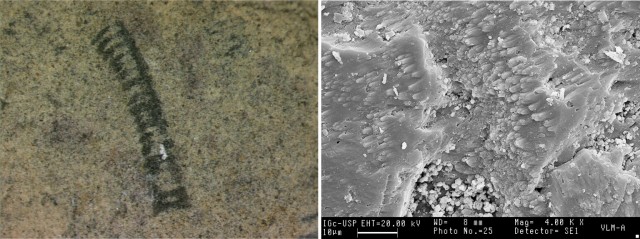
Corumbella fossil (left) and microphotograph of structure (right).
Courtesy of Lucas Warren
In the history of evolution, there have been few events more remarkable than the Cambrian explosion. After bacteria ruled the planet for some three billion years, a great variety of multicellular life burst onto the scene over the course of tens of millions of years, populating the rock record with a wealth of fossils. However, since its initial discovery, paleontologists have found that, at the very least, the Cambrian explosion had a fairly long fuse.
In the time leading up to the Cambrian period, which began about 540 million years ago, simple, multicellular animals show up in the rocks. Of these Ediacaran biota, most were soft-bodied, with no easily fossilizable hard parts. It’s been thought that some may have had exoskeletons made of chitin—like insects and crustaceans—but coming up with a fossil where the details of that exoskeleton are still preserved has been a tall task.
A recent paper in Geology, however, describes a unique specimen discovered in Paraguay. The organisms, immobile seafloor predators known as Corumbella werneri, were small and tube-shaped. Some of the original carbon remains, but most of the exoskeleton has been replaced by minerals—primarily calcite—which nonetheless appear to record some details of the exoskeleton’s structure. The elements present are consistent with a flexible, organic skeleton.
Read 5 remaining paragraphs | Comments
DIGITAL JUICE
No comments:
Post a Comment
Thank's!